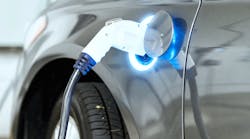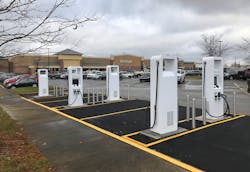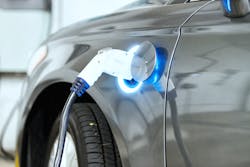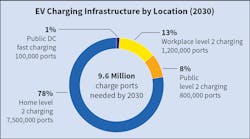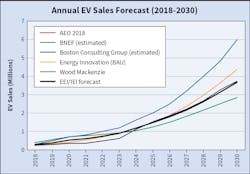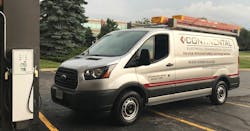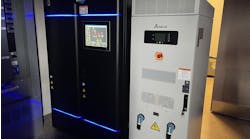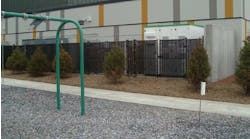Charge! That might be the rallying cry for more electrical designers and contractors as they witness the slow unfolding of an electrical vehicle (EV) revolution that will ultimately demand a highly reliable, responsive, and accessible vehicle battery-charging infrastructure.
From private residences, workplaces, and storefronts to shopping center parking lots, interstate highways, and public transportation/truck terminals, EV charging stations are on track to become, much like gas stations perhaps, part of the nation’s thoroughfare landscape. And, to the benefit of designs and construction professionals, they’ll all require application-specific design, configuration, connection, installation, maintenance, and servicing.
Various entities will be involved in that multi-layered effort, but the basic task of activating the charging units will fall to electrical services professionals. Some electrical contractors have been modestly cashing in for several years as EVs have become more popular. Now, they’re joined by others drawn to nascent opportunity in the space as the EV fleet expands and modernizes — and the need for a denser and more capable network of battery-charging port hubs becomes more obvious.
Continental Electrical Construction Co., Oak Brook, Ill., first eyed prospects in the market about seven years ago as it began building a renewable energy business, says Brian Haug, the company’s director of energy solutions. A state rebate program sparked local demand, and the company landed some work, but that was short-lived. But it forged relationships with charging unit suppliers — ones that have lately begun yielding a steadier stream of commercial charging station design and installation work. To date, the company has installed some 350 public chargers in the Chicago area.
“Some of the work is direct with commercial customers we’ve had for years, but most comes from charging unit suppliers like ChargePoint, SEMAConnect, and EVgo who reach out to us for design and installation services,” Haug says. “One of those relationships led us to install 100 units for area Walgreen stores.”
At a pace of one or two installs a month now, Continental’s charger business is a tiny piece of its overall revenue. But it’s being marketed to a degree, says company vice president Steve Witz, and could lead to something bigger over time.
“It could justify having one or two dedicated project managers focusing on this at some point,” he says.
Ozburn Electrical Contractors, Inc., Covington, Ga., has been diving deeper into the business as the need for chargers blossoms in an Atlanta metro area traversed by a growing number of EVs. Its experience with chargers dates to 2010, but only recently has installation work begun to ramp up, says Company President Terry Ozburn. Partnering with charger suppliers, it has been handling complete installation work, including subbing out related non-electrical tasks like excavation and concrete, at commercial and multi-family residential locations, and even some single-family residences. One of its biggest single jobs has been installing charging stations at 40 area Walgreens properties.
“This is becoming a pretty big market, and we’re going to market our services hard,” Ozburn says. “Over the next 10 years, there will be a lot more EVs on the road, and the charging infrastructure has to be in place. Someone has to put them [the charging units] in.”
EV Numbers Grow
Forecasts, of course, can be bold and end up being way off the mark. But there’s an emerging consensus that the EV revolution is well underway and unlikely to sputter. With more vehicle makers committing to future EV production, battery technology improving, the ranks of battery-charging products and services suppliers growing and government nudges toward green transportation growing more forceful, the EV future is coming into sharper focus. At this point, it looks like it will require charging resources far more robust than simple connections to 120V receptacle outlets in home garages.
In a report issued in November 2018, Edison Electric Institute and the Institute for Electric Innovation attached numbers to projections that both EVs and charger installations would grow over time (see Fig. 1 and Fig. 2). Distilling data from five independent forecasts, it concludes that by 2030, EVs on U.S. roads are likely to number 18.7 million, or perhaps 7% of the car and light truck fleet. That compares with some 1 million on the road today, an amount that could well double in just the next 18 to 24 months. Come 2030, annual EV sales will be humming, exceeding 3.5 million units, accounting for more than 20% of annual vehicle sales, projections suggest.
As that number swells, the report said, battery charging infrastructure growth and modernization must closely track to alleviate prospective EV owner concerns, including fears of mobility being limited by too few charging locations, or “range anxiety” as it’s known in EV circles. Framing the need, and not necessarily the expectation, the report said 9.6 million charging ports must be in operation to adequately service what’s likely to be both more demanding EVs and drivers. Most ports will continue to be at single-family homes, as is now the case, but 2.1 million, or 22%, will be in the public domain (900,000) or sited at workplaces (1.2 million) by then.
Other projections vary somewhat, such as a recent U.S. Department of Energy study that pegs the overall need notably lower than Edison’s based on a more modest 15-million EV estimate — some 627,000 public outlets by 2030. Either way, that’s a lot of ground to make up considering that the Edison report puts the number of public-space charge ports now in operation at only around 54,000. The number of worksite chargers currently in place is unknown, the report stated. The clear upshot: There’s a lot of work to do, and opportunity for those who can help get it done.
“The significant difference between the current availability of charging infrastructure and the expected charging infrastructure needed suggests a growing ‘infrastructure gap’ that must be addressed,” wrote the report’s authors Adam Cooper and Kellen Schefter.
Whether the gap can be narrowed as the EV numbers grow and ultimately be closed at some fixed future date, is the pressing question for stakeholders. Vehicle makers mapping their EV futures, governmental entities incentivizing or mandating moves to green transportation, electric utilities projecting demand and grid capabilities, and the various parties involved in building out the network are all at the table. Their actions will determine whether goals will be met, a worrisome reality given the independence of the parties on one hand, but their interdependence on the other. But it will ultimately fall to that consortium to create an optimal battery-charging infrastructure, one with adequate numbers and mixes of charger types installed in the right places. No central hand is guiding or funding that effort nationally, but work is well underway on numerous fronts to achieve that goal — and some initiatives approximate a command-and-control approach.
The Build-Out
One that comes close is being led by Electrify America, LLC, a subsidiary formed by Volkswagen Group of America in 2017. It is funding and shepherding a long-term EV infrastructure push agreed to in a settlement with the U.S. Environmental Protection Agency for perpetrating a vehicle emissions scandal. Spending $2 billion of its own money over 10 years, it is broadly promoting adoption of EV transportation in the United States, including a dedicated earmark of $800 million for California, with the bulk of the money funding construction of its own multi-faceted, publicly accessible charger network.
In the initial 30-month development phase, on track for completion at the end of 2019, Electrify America was to have built a network of 2,000 so-called fast chargers — a reference to their comparative charging speed over standard chargers seen in home garages and many existing public locations — distributed among 500 stations across the country. Groupings of DC fast chargers (DCFCs) are being deployed in stations with individual port charging power levels up to 350kW along high-traffic corridors in 39 states. In addition, public stations with DCFCs and/or AC Level 2 fast chargers delivering up to 150kW charging speeds are going up in 17 of the nation’s largest cities, and AC chargers are being installed at more than 300 multi-family units and businesses catering to employees with EV charging needs.
As its first funding phase winds down, Electrify America is beginning a second round of expenditures that will include more allotments for infrastructure. Through the end of 2021, it plans to spend another $235 million, with 65% going to expanded and targeted-use metro area charging; 32% going to additional highway and regional route stations; and the balance to small experiments with both autonomous vehicle charging stations and renewable energy-powered stations. In total, another 200 charging stations could be added.
As simple as charger installation might appear, especially if the comparison is drawn with putting in standard home garage chargers, the Electrify America project, and others like it, is a demanding one, logistically and sometimes technically. It retained two companies, Black & Veatch, Kansas City, Mo., and SAI Group, Salem, N.H., to geographically split the design, permitting, and construction work on the stations, calling on each firm’s design-build expertise and project-specific experience. Both function as general construction contractors, supplying their own labor for some tasks but also hiring and overseeing electrical contractors and other subs.
For Black & Veatch, which has responsibility for 24 states and the distinct California work, the task is familiar, having been instrumental in helping EV maker Tesla build its own proprietary high-speed charging network beginning six years ago.
“This infrastructure is heavily oriented to DC fast charging, and we had a lot of experience in-house with national deployment of that kind of network,” says Maryline Daviaud Lewett, director of business development with the company’s transformative technologies division.
EC Opportunity
Electrical contractors, often more national in scope and usually hired from a list of pre-qualified firms that bid for the jobs, provide the critical expertise and experience needed to handle work that doesn’t always go by the book.
“Contractors need to be experienced in DC power; it can be a lot easier to deploy AC, 240V, 40A systems,” says Lewett. “And there can be a lot of configuration and on-site customization, since there’s often not enough power on site, so it requires coordination with utilities.”
The logistics of getting charging stations installed has been one of the most challenging elements of the infrastructure development work that Rosendin Electric, a San Jose, Calif.-based electrical contractor, has taken on, says Brian Smith, the firm’s special projects division manager. In the nearly 100 projects it’s performed, including some recently for the Electrify America program, the work is done on a turnkey basis, with the company assuming management of nearly all components, most of which prove more challenging than the electrical, Smith says.
“We do the design and installation, everything except handling the host site agreement,” he says. “When we get the job, we walk the project for design and get the civil layout, start work on getting it permitted and then getting it built, running the electrical infrastructure underground. Scheduling, getting the civil work and permits handled is tougher. City building departments are often the biggest hurdle because they often don’t know much about this.”
Also, partners in many of the projects Rosendin has taken on have tended to overlook the complicating nuances of getting charging stations up and running.
“In the beginning, most guys doing these initiatives didn’t know much about construction,” says Tom Gusiff, a Rosendin project manager. “As this has developed, they’ve brought in more construction-minded people so they’re starting to realize more of what it takes to get these things going.”
The market looks more hospitable in that regard, Smith says, especially as ambitious initiatives like Electrify America take root, automakers get involved, and utilities with a lot at stake take a more active role in deploying charging stations and planning for how to accommodate and leverage a large EV charging infrastructure. All of that bodes well for Rosendin going after more work in the area.
“In California, based on the number of EVs that have been sold, only 4% of the needed infrastructure is currently installed,” says Smith. “It’s starting to look like an arms race to get these stations in the ground. Things could really explode, quick.”
But the challenge isn’t framed by sheer numbers. The need for a massive infusion of more charging locations, carefully sited to serve expected EV ownership concentrations and traffic patterns and a public and commercial transit infrastructure certain to integrate more EVs, is plainly evident. What’s more vexing is the need for an increasingly sophisticated and capable infrastructure that’s aligned with coming generations of more powerful batteries, the demand for faster charging, the likely adaptation of solar-powered charging and an electric grid that could be stressed by the load implications of a fast-growing web of power-thirsty battery chargers. Future design and installation work must reflect those considerations, and the skills of companies working in the space as it evolves will be tested. What’s coming in EV charging is away from home garage battery chargers, says Dan Bowermaster, program manager for electric transportation at Electric Power Research Institute (EPRI).
“The big gap that exists now is in how to scale this up in a cost-effective way,” he says. “Charging power levels on the light duty side were 50kW, and now we’re moving into 150kW, 250kW, and 350kW per vehicle, meaning a typical station is going to be 3.5MW. On the DCFC side, the smallest of these stations is going to be the size of a 7-Eleven store. All of this presents a good opportunity for the right contractors.”
Zind is a freelance writer based in Lees Summit, Mo. He can be reached at [email protected].
Sidebar: Getting Ahead of the EV Battery-Charging Curve
Electric vehicles remain on the periphery of the nation’s transportation infrastructure, but planning for a time when they’re much more commonplace could be smart, and in a small number of cases, law-abiding.
Electrical design and contracting professionals might consider that as they consult with clients on new residential and commercial building projects, and perhaps others, that could someday benefit from having EV battery-charging units on the premises. That day may be far off, but the best construction advice might be to either add them in or do the electrical work up front to simplify future installation.
The alternative, postponing a decision, could be the worst option — one that could run afoul of laws being passed in some jurisdictions requiring more new buildings to be EV-charger equipped or ready. One of the latest is Seattle, where all new buildings with off-street parking must offer EV charging.
Electrically retrofitting a built site for chargers, specifically areas where vehicles owned by tenants, employees, or even the public might charge their EVs, could be costly and disruptive. Instead, doing the required electrical work during construction, installing chargers or prepping the site for their eventual addition, is often the better route — and one more new properties are taking.
“We’re seeing many apartment complexes, high-rises, and individual business locations being built with the capacity to put chargers in or overtly showing them installed on drawings,” says Steve Witz, vice president at Continental Electrical Construction Co., an Oak Brook, Ill.-based electrical contractor that has been handling more EV charger installation work in the Chicago area.
Properties built with electrical infrastructure that allows easy charger unit installation at a future date are becoming more commonplace, especially in urban areas where EVs could proliferate and lead to demand for more powerful charging stations that could supplement home-based charging. Reasons vary — from making properties more attractive to flashing “green” credentials to responding to government mandates — but economics is one key motivation.
A 2016 study, Plug-In Electric Vehicle Infrastructure Cost-Effectiveness Report for San Francisco, commissioned by a California utilities group, determined that it would be four times costlier to later add an EV charger-outfitted parking space to a project than it would be to install a complete electric circuit for PEV charging during new construction.
“Installing infrastructure during new construction can avoid retrofit costs including breaking and repairing walls, longer raceways using more expensive methods, and upgrading electric service panels,” the report stated. “In addition, the soft costs such as permitting and inspections and project management are much lower for new construction.”
The solution for projects wanting to plan for an EV future is EV-ready or EV-capable construction. For the former, that generally means installing electrical panel capacity and conduit to terminate in a junction box or 240V charging outlet; for the latter, installing electrical panel capacity with a dedicated branch circuit and continuous raceway from the panel to an eventual charger location. Whatever the approach, evidence suggests the alternative (procrastination) is not the best route.
